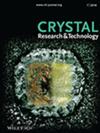不同分子排列导致不同的脱溶速率:2,7 -二溴- 9H -咔唑溶剂化物的稳定性研究
IF 1.9
4区 材料科学
Q3 CRYSTALLOGRAPHY
引用次数: 1
摘要
溶剂化物的稳定性在晶体工程领域具有重要意义。分子间的相互作用和堆积方式是影响溶剂化物稳定性的重要因素。本研究选择2,7 -二溴- 9H -咔唑作为模型化合物,研究分子堆积方式对溶剂化物稳定性的影响。通过重结晶得到了2,7 -二溴- 9H -咔唑的无水形态和5种溶剂化物。通过热重分析、热级显微镜和红外光谱研究了5种溶剂化物的脱溶现象,发现溶剂化物的稳定性为N,N‐二甲基乙酰胺溶剂化物>二甲基亚砜溶剂化物> N,N‐二甲基甲酰胺溶剂化物>二氧环溶剂化物>乙腈溶剂化物。用单晶X射线衍射分析了晶体结构,并用Hirshfeld表面分析法分析了晶体中的分子间相互作用。结果表明,五种溶剂化物的稳定性与分子在晶体中的排列方式有关。结果表明,不稳定溶剂中溶质分子和溶剂分子呈层间模式排列,而稳定溶剂中溶质分子和溶剂分子呈交错模式排列。本文章由计算机程序翻译,如有差异,请以英文原文为准。
Various Molecular Arrangements Leading to Different Desolvation Rates: Research on the Stability of 2,7‐Dibromo‐9H‐carbazole Solvates
The stability of solvates is very important in the field of crystal engineering. Molecular interaction and packing mode are important factors affecting the stability of solvates. In this study, 2,7‐dibromo‐9H‐carbazole is selected as the model compound to investigate the influence of molecular stacking mode on the stability of solvates. An anhydrous form and five solvates of 2,7‐dibromo‐9H‐carbazole are obtained by recrystallization. The desolvation phenomena of the five solvates are studied by thermogravimetric analysis, hot stage microscope, and infrared spectroscopy and it is found that the stability of the solvates is N,N‐dimethylacetamide solvate > dimethyl sulfoxide solvate > N,N‐dimethylformamide solvate > dioxane solvate > acetonitrile solvate. Crystal structures are analyzed by single crystal X‐ray diffraction and Hirshfeld surface analysis is also applied to analyze the intermolecular interactions in the crystals. The results show that the stability of the five solvates is related to the packing modes of the molecules in the crystal. It is suggested that the solute molecules and solvent molecules in the unstable solvates are arranged in the interlayer mode, while they are arranged in a staggered mode in stable solvates.
求助全文
通过发布文献求助,成功后即可免费获取论文全文。
去求助
来源期刊
自引率
6.70%
发文量
121
审稿时长
1.9 months
期刊介绍:
The journal Crystal Research and Technology is a pure online Journal (since 2012).
Crystal Research and Technology is an international journal examining all aspects of research within experimental, industrial, and theoretical crystallography. The journal covers the relevant aspects of
-crystal growth techniques and phenomena (including bulk growth, thin films)
-modern crystalline materials (e.g. smart materials, nanocrystals, quasicrystals, liquid crystals)
-industrial crystallisation
-application of crystals in materials science, electronics, data storage, and optics
-experimental, simulation and theoretical studies of the structural properties of crystals
-crystallographic computing

 求助内容:
求助内容: 应助结果提醒方式:
应助结果提醒方式:


